

Japanese Surrender

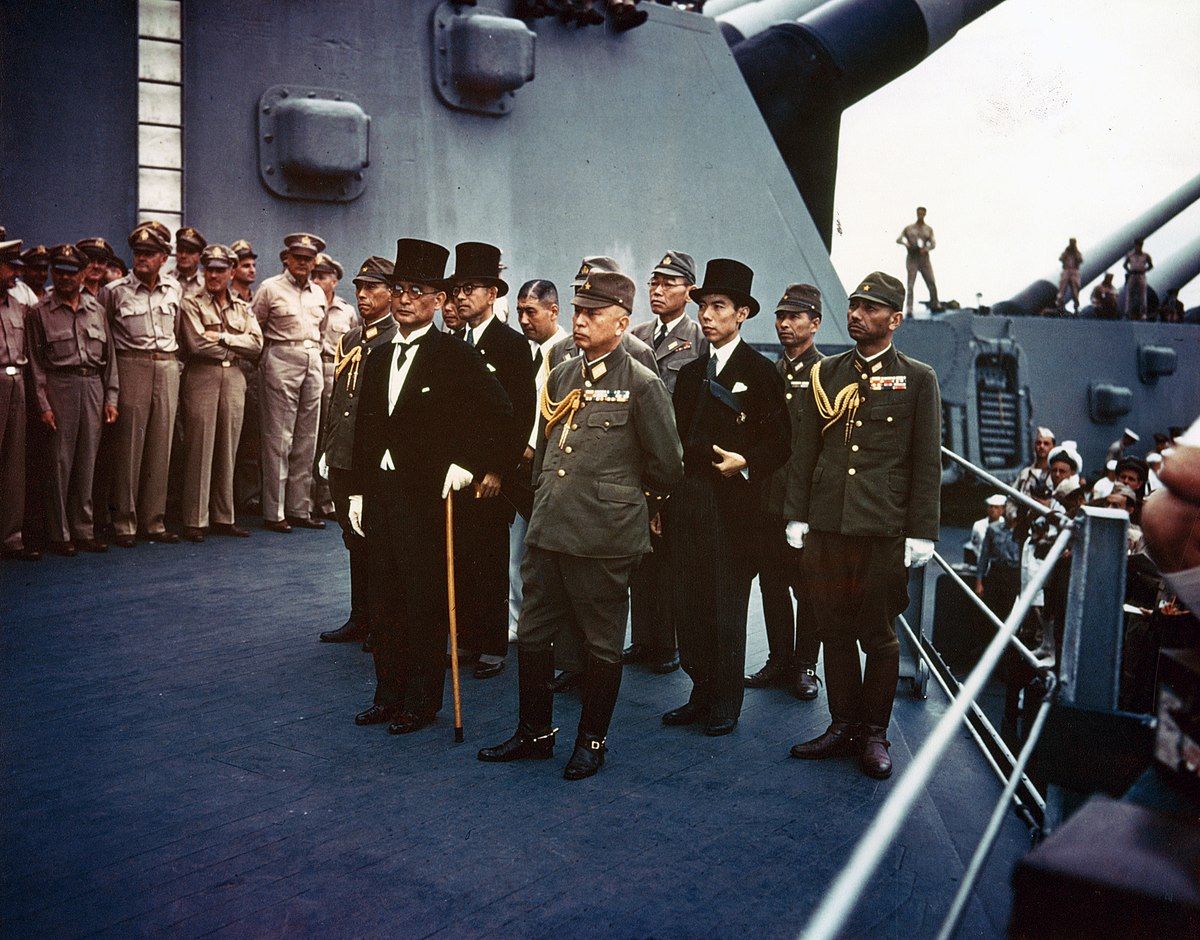
Click on photo to zoom
Aboard the U.S.S. Missouri, Tokyo Bay, September 2, 1945
The Japanese Instrument of Surrender was the written agreement that formalized the surrender of the Empire of Japan, marking the end of World War II. It was signed by representatives from the Empire of Japan, the United States of America, the Republic of China, the United Kingdom of Great Britain and Northern Ireland, the Union of Soviet Socialist Republics, the Commonwealth of Australia, the Dominion of Canada, the Provisional Government of the French Republic, the Kingdom of the Netherlands, and the Dominion of New Zealand. The signing took place on the deck of USS Missouri in Tokyo Bay on September 2, 1945.
The date is sometimes known as Victory over Japan Day, although that designation more frequently refers to the date of Emperor Hirohito's Imperial Rescript of Surrender, the radio broadcast announcement of the acceptance of the terms of the Potsdam Declaration at noon Japan Standard Time on August 15.
The ceremony aboard the deck of the Missouri lasted 23 minutes and was broadcast throughout the world. The instrument was first signed by the Japanese foreign minister Mamoru Shigemitsu "By Command and on behalf of the Emperor of Japan and the Japanese Government" (9:04 am). General Yoshijirō Umezu, Chief of the Army General Staff, then signed the document "By Command and on behalf of the Japanese Imperial General Headquarters" (9:06 am).
At 9:08 a.m., U.S. General of the Army Douglas MacArthur, the Commander in the Southwest Pacific and Supreme Commander for the Allied Powers, accepted the surrender on behalf of the Allied Powers and signed in his capacity as Supreme Commander.
After MacArthur's signature as Supreme Commander, the following representatives signed the instrument of surrender on behalf of each of the Allied Powers:
- Fleet Admiral Chester Nimitz for the United States (9:12 a.m.)
- General Hsu Yung-chang for China (9:13 a.m.)
- Admiral Sir Bruce Fraser for the United Kingdom (9:14 a.m.)
- Lieutenant General Kuzma Derevyanko for the Soviet Union (9:16 a.m.)
- General Sir Thomas Blamey for Australia (9:17 a.m.)
- Colonel Lawrence Moore Cosgrave for Canada (9:18 a.m.)
- Général de Corps d'Armée Philippe Leclerc de Hauteclocque for France (9:20 a.m.)
- Lieutenant Admiral C. E. L. Helfrich for the Netherlands (9:21 a.m.)
- Air Vice-Marshal Leonard M. Isitt for New Zealand (9:22 a.m.)
The UK invited Dominion governments to send representatives to the ceremony as subordinates to its own. MacArthur supported the government of Australia's demand to attend and sign separately from the UK, although Australia objected to his recommendation that Canada, the Netherlands, and France also sign the document.
On September 6, Colonel Bernard Theilen took the document and an imperial rescript to Washington, D.C., and presented them to President Harry S. Truman in a formal White House ceremony the following day. The documents were then exhibited at the National Archives. The Allied copy of the Instrument is permanently exhibited at the United States National Archives Building in Washington, D.C.. A replica of the Japanese version can be viewed at the Edo-Tokyo Museum in Tokyo.
As witnesses, American general Jonathan Wainwright, who had surrendered the Philippines, and British lieutenant-general Arthur Percival, who had surrendered Singapore, received two of the six pens used by General MacArthur to sign the instrument. Another pen went to the West Point military academy, and one to MacArthur's aide. All of the pens used by MacArthur were black, except the last, which was plum-colored and went to his wife. A replica of it, along with copies of the instrument of surrender, is in a case on Missouri by the plaque marking the signing spot. The model of the USS Missouri in the National Museum of the United States Navy at the Washington Navy Yard, has a scale replica of the signing table in the correct location.
Source: Wikipedia
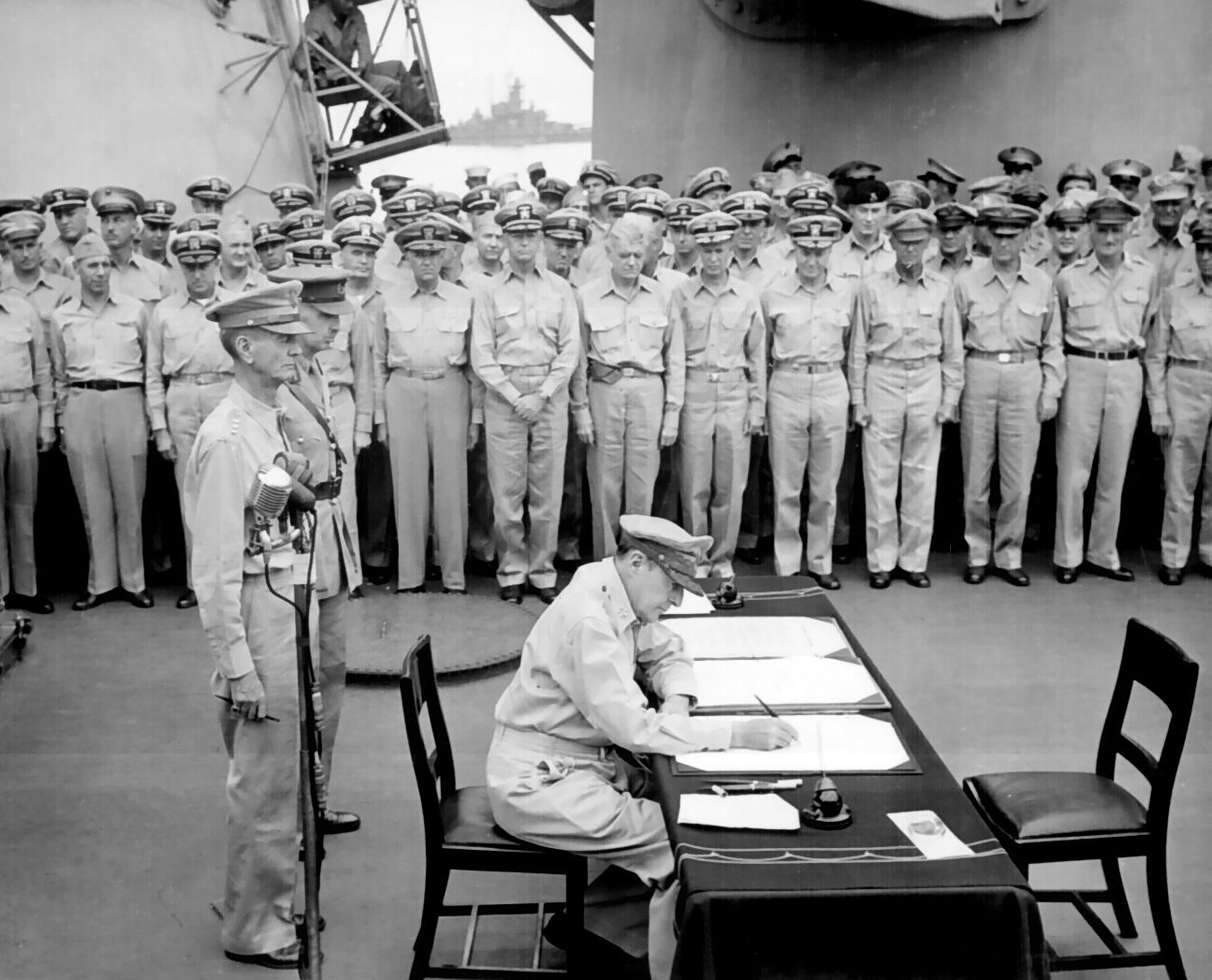
General MacArthur, Supreme Commander for the Allied Powers, accepted the surrender on behalf of the Allied Powers
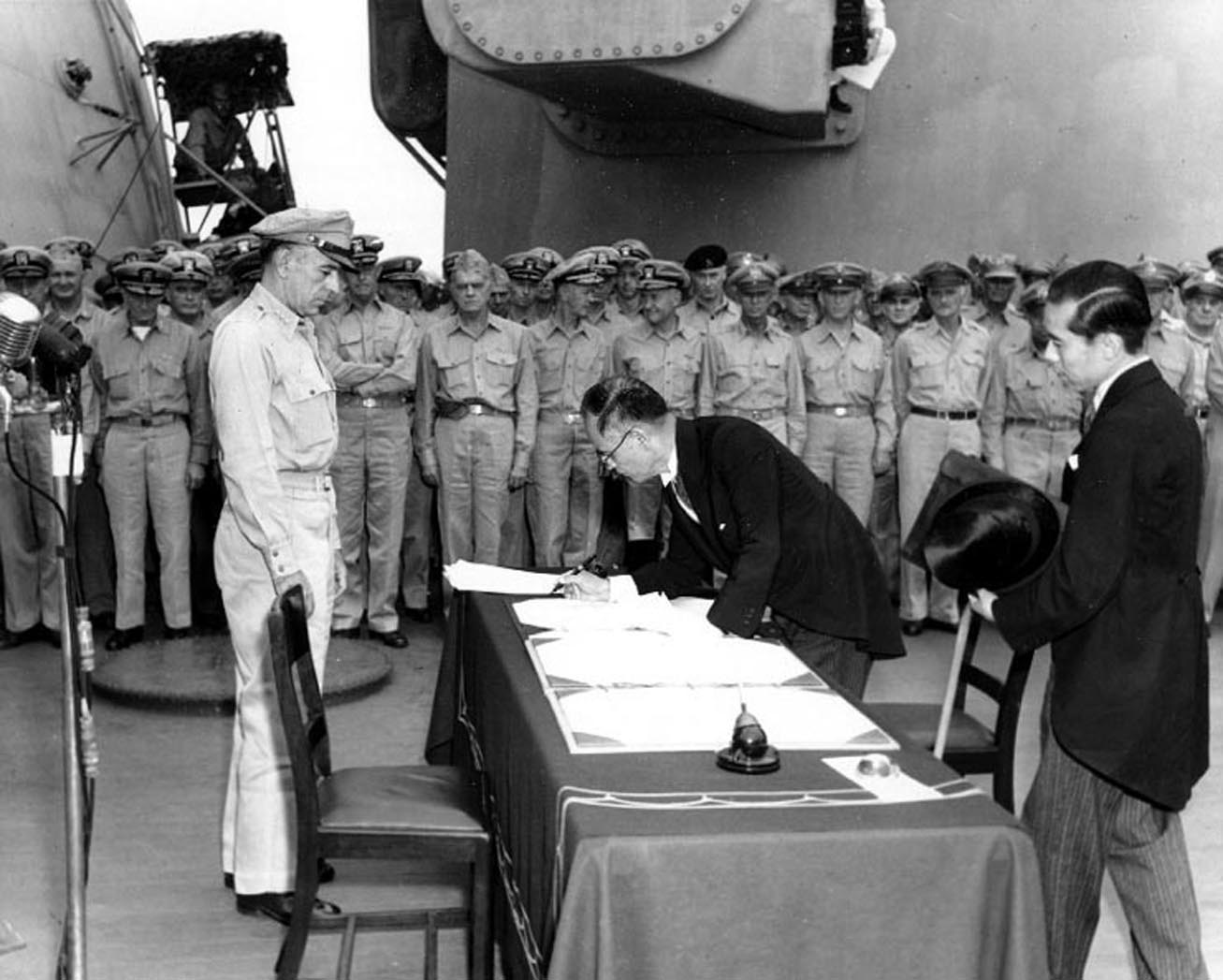
Japanese foreign minister Mamoru Shigemitsu signs on behalf of the Emperor of Japan and the Japanese Government
Click on any photo to zoom
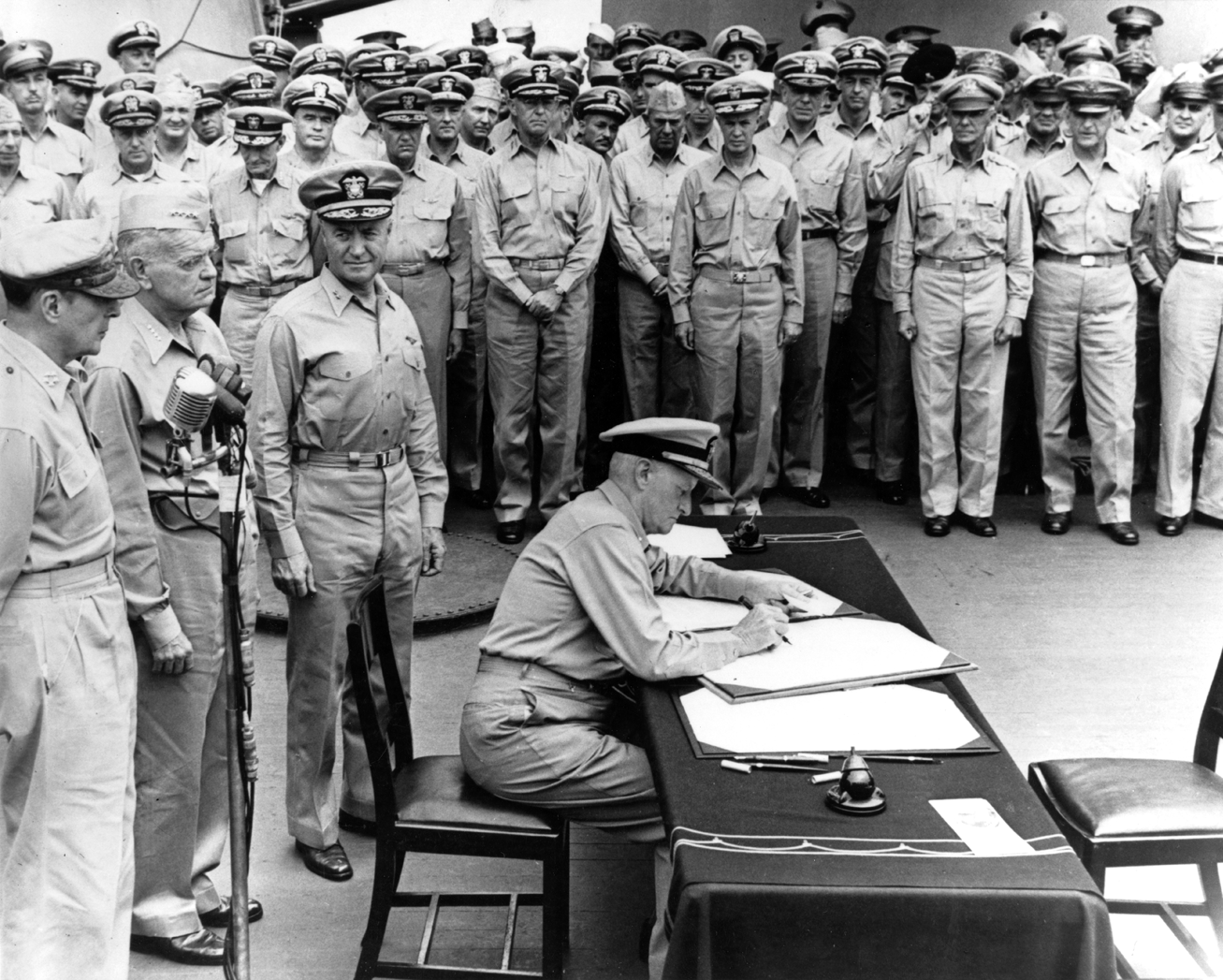
Fleet Admiral Chester Nimitz signs for the United States
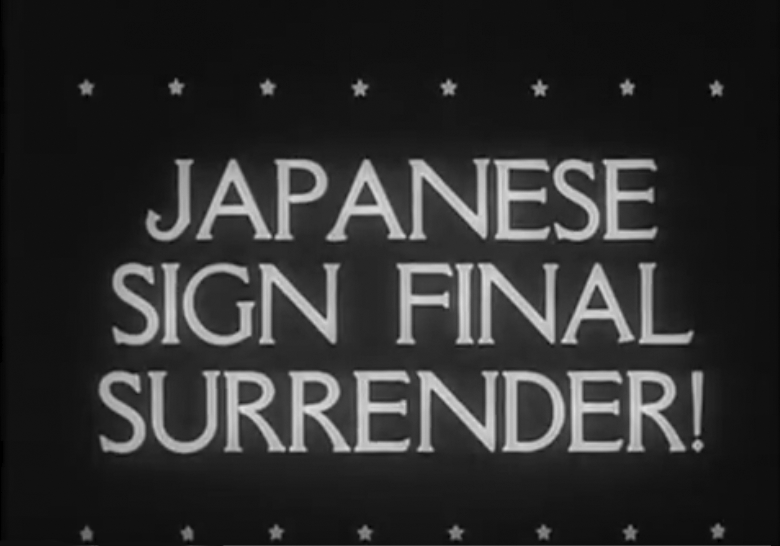
News reel of the surrender ceremony on board the USS Missouri in Tokyo Bay on September 2, 1945. Background music is "With Honor Crowned". Click to play video.
General Douglas MacArthur: “Today the Guns are Silent”
We are gathered here, representatives of the major warring powers—to conclude a solemn agreement whereby peace may be restored. The issues involving divergent ideals and ideologies, have been determined on the battlefields of the world and hence are not for our discussion or debate. Nor is it for us here to meet, representing as we do a majority of the people of the earth, in a spirit of distrust, malice or hatred. But rather it is for us, both victors and vanquished, to rise to that higher dignity which alone befits the sacred purposes we are about to serve, committing all our people unreservedly to faithful compliance with the obligation they are here formally to assume.
It is my earnest hope and indeed the hope and indeed the hope of all mankind that from this solemn occasion a better world shall emerge out of the blood and carnage of the past—a world founded upon faith and understanding—a world dedicated to the dignity of man and the fulfillment of his most cherished wish—for freedom, tolerance and justice.
The terms and conditions upon which the surrender of the Japanese Imperial Forces is here to be given and accepted are contained in the Instrument of Surrender now before you.
As Supreme Commander for the Allied Powers, I announce it my firm purpose, in the tradition of the countries I represent, to proceed in the discharge of my responsibilities with justice and tolerance, while taking all necessary dispositions to insure that the terms of surrender are fully, promptly and faithfully complied with.
When the assembled representatives of the Allied Powers and of Japan had finished signing the agreements, General MacArthur, MacArthur stated:
Let us pray that peace be now restored to the world and that God will preserve it always. These proceedings are closed.
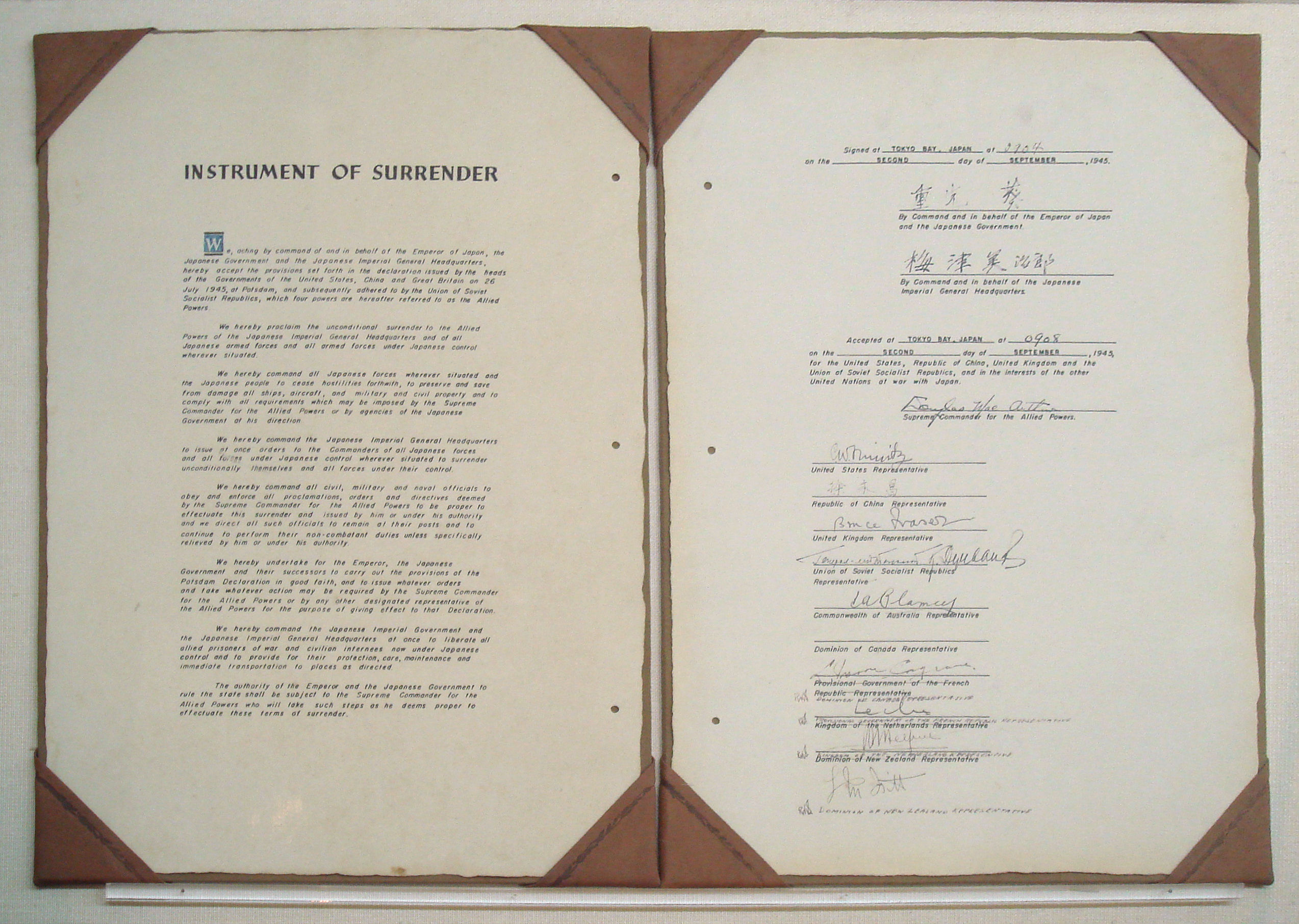
Allied copy of the Instrument of Surrender. Click to zoom.
The General then addressed the American people by radio as follows:
“Today the guns are silent. A great tragedy has ended. A great victory has been won. The skies no longer rain death -- the seas bear only commerce men everywhere walk upright in the sunlight. The entire world is quietly at peace. The holy mission has been completed. And in reporting this to you, the people, I speak for the thousands of silent lips, forever stilled among the jungles and the beaches and in the deep waters of the Pacific which marked the way. I speak for the unnamed brave millions homeward bound to take up the challenge of that future which they did so much to salvage from the brink of disaster.
As I look back on the long, tortuous trail from those grim days of Bataan and Corregidor, when an entire world lived in fear, when democracy was on the defensive everywhere, when modern civilization trembled in the balance, I tank a merciful God that He has given us the faith, the courage and the power from which to mold victory. We have known the bitterness of defeat and the exultation of triumph, and from both we have learned there can be no turning back. We must go forward to preserve in peace what we won in war.
A new era is upon us. Even the lesson of victory itself brings with it profound concern, both for our future security and the survival of civilization. The destructiveness of the war potential, through progressive advances in scientific discovery, has in fact now reached a point which revises the traditional concepts of war.
Men since the beginning of time have sought peace. Various methods through the ages have attempted to devise an international process to prevent or settle disputes between nations. From the very start workable methods were found insofar as individual citizens were concerned, but the mechanics of an instrumentality of larger international scope have never been successful. Military alliances, balances of power, leagues of nations, all in turn failed, leaving the only path to be by way of the crucible of war. We have had our last chance. If we do not now devise some greater and more equitable system, Armageddon will be at our door. The problem basically is theological and involves a spiritual recrudescence and improvement of human character that will synchronize with our almost matchless advances in science, art, literature and all material and cultural developments of the past two thousand years, It must be of the spirit if we are to save the flesh.
We stand in Tokyo today reminiscent of our countryman, Commodore Perry, ninety-two years ago. His purpose was to bring to Japan an era of enlightenment and progress, by lifting the veil of isolation to the friendship, trade, and commerce of the world. But alas the knowledge thereby gained of western science was forged into an instrument of oppression and human enslavement. Freedom of expression, freedom of action, even freedom of thought were denied through appeal to superstition, and through the application of force. We are committed by the Potsdam Declaration of principles to see that the Japanese people are liberated from this condition of slavery. It is my purpose to implement this commitment just as rapidly as the armed forces are demobilized and other essential steps taken to neutralize the war potential.
The energy of the Japanese race, if properly directed, will enable expansion vertically rather than horizontally. If the talents of the race are turned into constructive channels, the county can lift itself from its present deplorable state into a position of dignity.
To the Pacific basin has come the vista of a new emancipated world. Today, freedom is on the offensive, democracy is on the march. Today, in Asia as well as in Europe, unshackled peoples are tasting the full sweetness of liberty, the relief from fear.
In the Philippines, America has evolved a model for this new free world of Asia. In the Philippines, America has demonstrated that peoples of the East and peoples of the West may walk side by side in mutual respect and with mutual benefit. The history of our sovereignty there has now the full confidence of the East.
And so, my fellow countrymen, today I report to you that your sons and daughters have served you well and faithfully with the calm, deliberated determined fighting spirit of the American soldier, based upon a tradition of historical truth as against the fanaticism of an enemy supported only by mythological fiction. Their spiritual strength and power has brought us through to victory. They are homeward bound—take care of them.”

